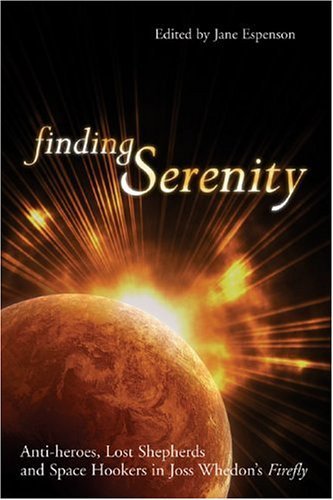Jane Espenson and Glenn Yeffeth, eds.
Finding Serenity
Anti-heroes, Lost Shepherds, and Space Hookers
in Joss Whedon’s Firefly
reviewed by Lewayne L. White

|
|
Publisher: Benbella, 2005 Paperback: $17.95 U.S. Length: 238 pages ISBN: 1-932100-43-1 |
Finding Serenity is a collection of essays regarding Joss (Buffy The Vampire Slayer, Angel) Whedon’s doomed TV series Firefly. For those unfamiliar with the series, it combines the western and sci-fi / fantasy genres, and followed a mixed crew of anti-heroes aboard a Firefly class cargo ship called Serenity.
The series went through unrealistic network hurdles, ratings hell, and was finally dropped before it had barely begun. It had promise, intelligence, originality, and a small but fiercely loyal audience, who often called themselves Browncoats after the Independent forces in the show’s backstory. This devoted following helped give the cancelled show a second life via DVD and the eventual release of the feature film Serenity.
I wondered for some time whether to submit this review, because by the time I’d read the book in question, millions of words about its subject had likely been written. After all, I came late to the Firefly universe. I wasn’t one of the legions of Browncoats who sweated blood, tears, and money to get the film into production. I don’t sprinkle my speech with Firefly colloquialisms like “shiny” or “gorram,” or bastardized Chinese phrases.
My first real experience with Joss Whedon’s ’verse came Sept. 30, 2005 via the feature film Serenity. By now, plenty has already been said about Firefly and by more informed and more qualified writers.
Which brings me to the second reason I hesitated in reviewing this book. The authors of the essays contained in Finding Serenity include Mercedes Lackey (author of 60+ books), Nancy Holder (multiple Bram Stoker winner), David Gerrold (TV writer, author, Hugo, Nebula, and Locus winner) as well as other SF/fantasy authors and editors, instructors in music and language, and some PhD’s.
I’ve had small roles in a couple of very independent films, published a handful of stories, begun several novels, wrote one really inept screenplay during high school, and lasted about three semesters at university. These are not exactly competitive qualifications.
Was I really in a position to review, let alone disagree with, some of the essayists in the analysis of gender roles in Whedon’s universe, whether Asian props really mean Asian inclusion, the role of existentialism in Firefly, or whether Firefly was better than Star Trek? (Okay, I could probably handle that last one.)
Many of the essays In Finding Serenity are serious, scholarly works analyzing gender/sex roles, societal structure and mores, philosophy, religion, love, sex, honor, chivalry, the power of myth, and the cross-breeding of fiction genres. They will be of particular interest to students of writing, particularly for film and television, and are worthy of inclusion in courses on those subjects. They impressed the hell out of me, but may not necessarily appeal to the casual reader, or even a diehard Firefly fan. And, as I mentioned, I also disagree with the content of some.
Another group of essays, particularly “More Than A Marriage of Convenience,” “The Captain May Wear the Tight Pants...” “Rise and Fall (and Rise) of Firefly,” and “Mirror/Mirror,” say more about Firefly from the perspective of people who just loved the show. And perhaps more about why they loved the show. They are less serious in style, relying at times on satire and parody, and are more accessible to fans and casual readers.
I can’t explain “Firefly vs. The Tick.”
One of the most enjoyable essays is the least technical and the most revealing. Jewel (Kaylee Frye, ship’s mechanic) Staite’s “Kaylee Speaks” is an episode by episode list of the actress’s favorite bits, including favorite lines, scenes, and characters. It’s not a lesson in filmmaking, or a lecture on Deep Hidden Meaning. It’s a reminder of what made the series great: the sense that the characters were real people you could love or hate, and who lived in a real universe.
Unlike the sterile, utopian Star Trek universe, Firefly’s universe was dirty and hard, and sometimes the lines got blurred. The characters had no time to save the universe. They were busy trying to keep their ship fueled and stocked, and themselves below the radar. Sometimes the good guys did ugly things.
Unlike the Empire of Star Wars. the faceless Alliance wasn’t always faceless, and maybe it wasn’t uniformly “evil” as much as thinly stretched and overseeing cultures it couldn’t understand.
Sometimes characters died, and they stayed dead. No alternate universe exists in which they still lived, and no visit from beyond via The Force. And perhaps most important of all, you cared whether they lived or died.
Overall, Finding Serenity is a mixed bag ranging from highly critical to simply silly, with the full range of good and bad material in between. It’s all well written, but for some readers the different and occasionally conflicting perspectives of the authors may take a little joy from the show.
If you’re a Browncoat, you may want this book to complete a collection, but you won’t like all of it. It’s great for stimulating intelligent discussions about the show, but if you’re a serious Browncoat, you probably don’t need help discussing “Firefly.”
If, like me, you’ve enjoyed the show and film, you might find this book interesting. But if you can get it from a library, do so. Some of the essays will enhance your appreciation of the show.
If you’re new to the Firefly universe, do not, under any circumstances, read this book before completely experiencing Firefly for yourself. Watch the DVDs a few times and enjoy the show for what it is, appreciate what might have been, then decide how badly you want someone else to analyze the layers of your new favorite show for you.
Copyright © 2006 by Lewayne L. White

